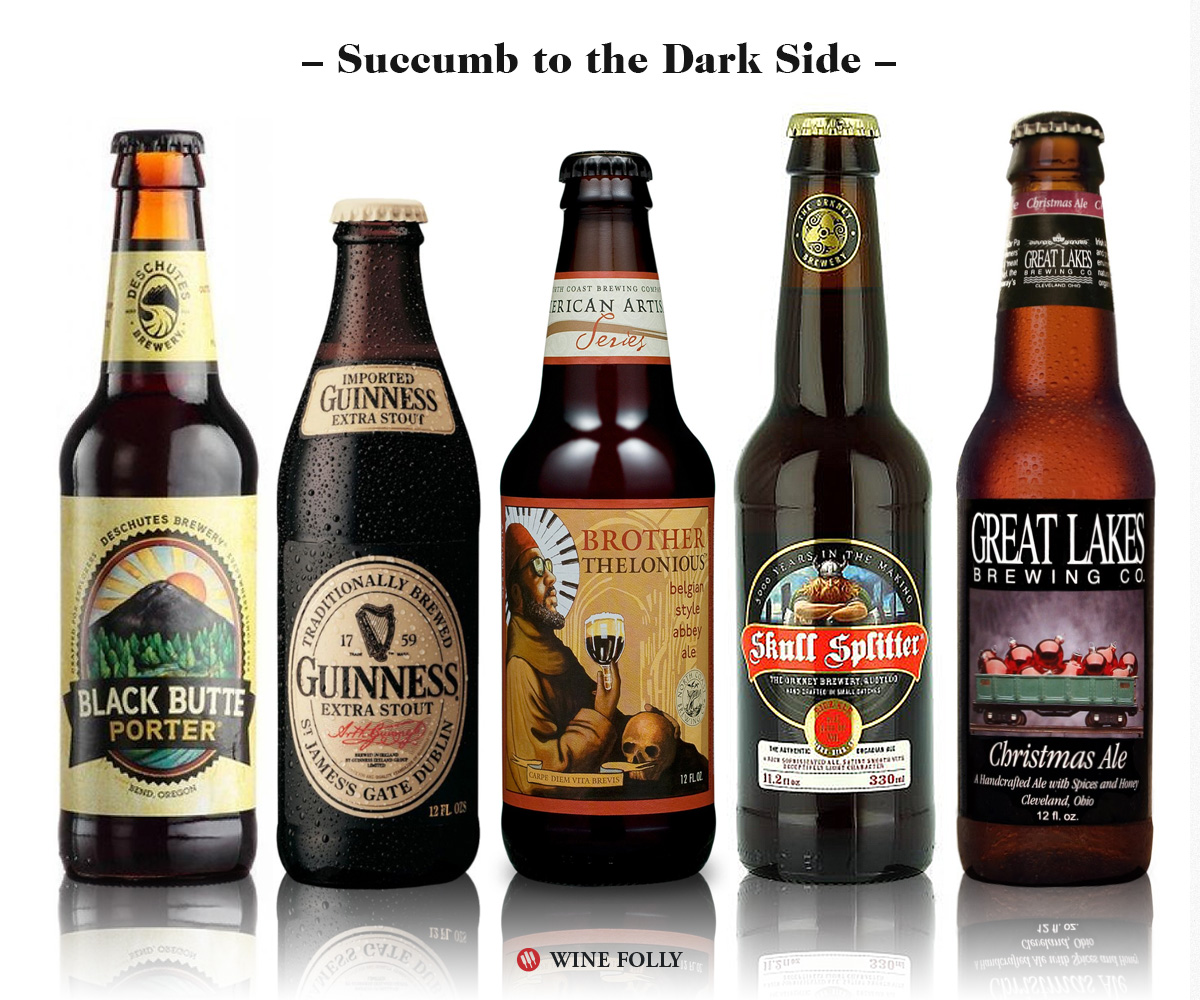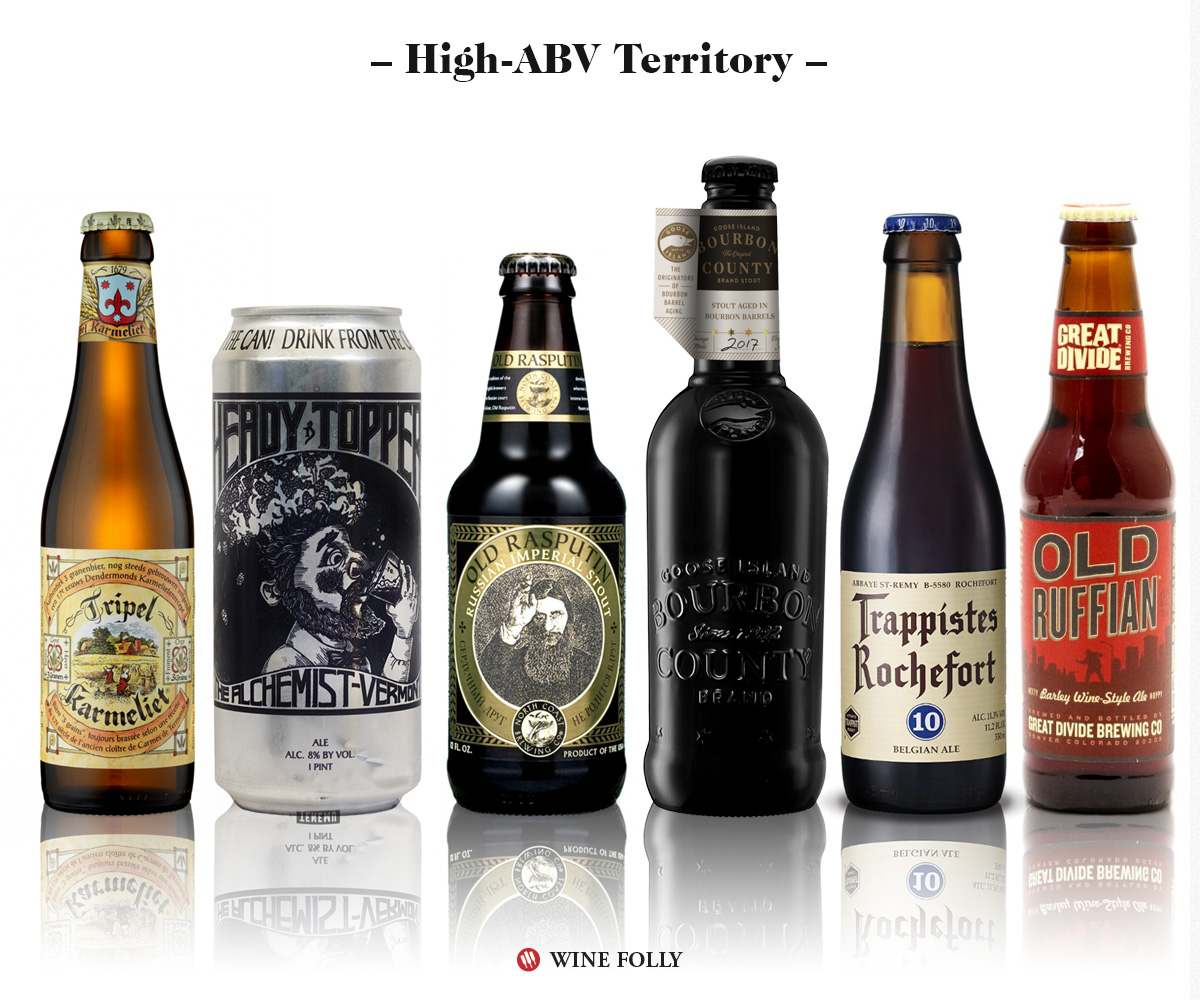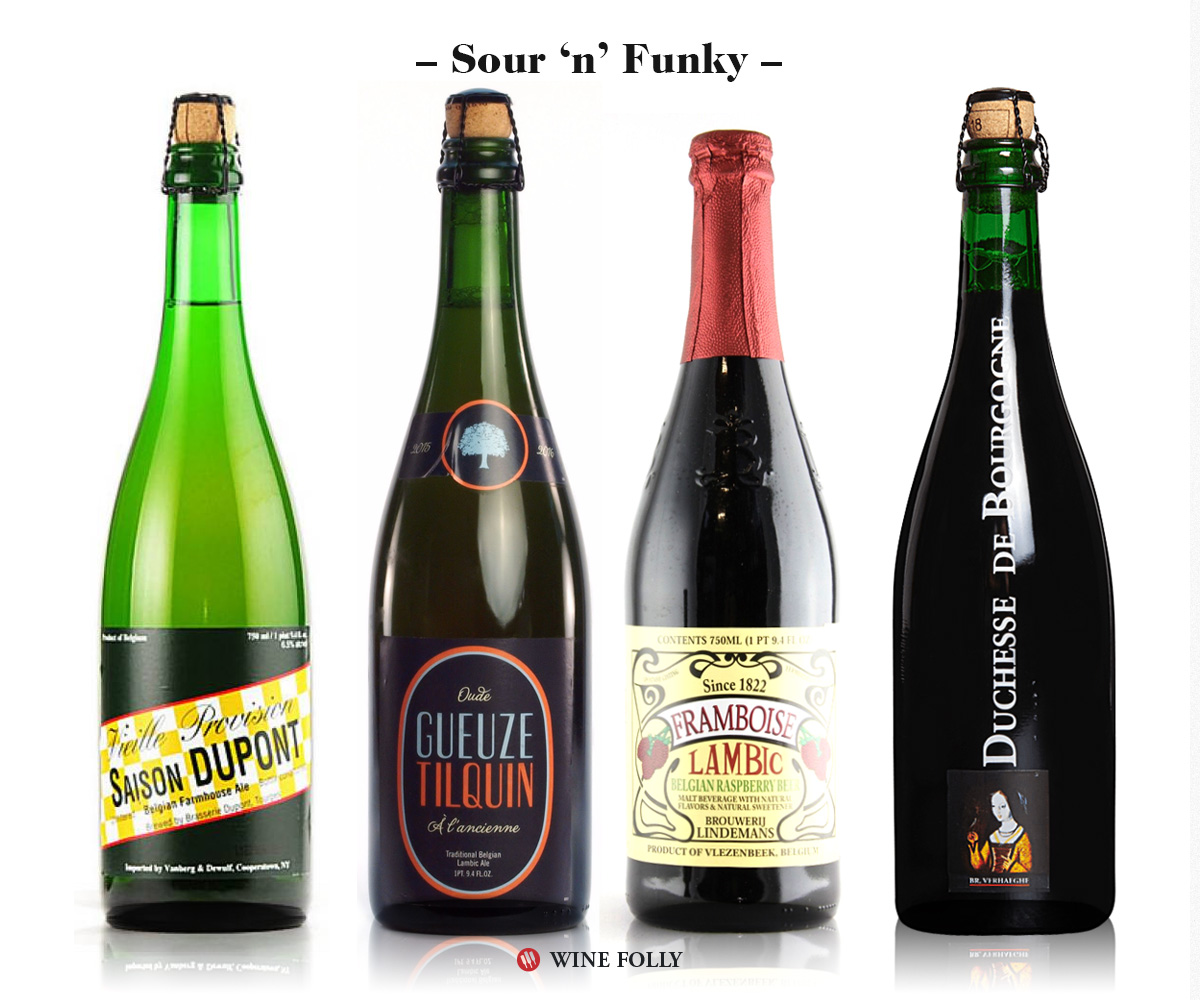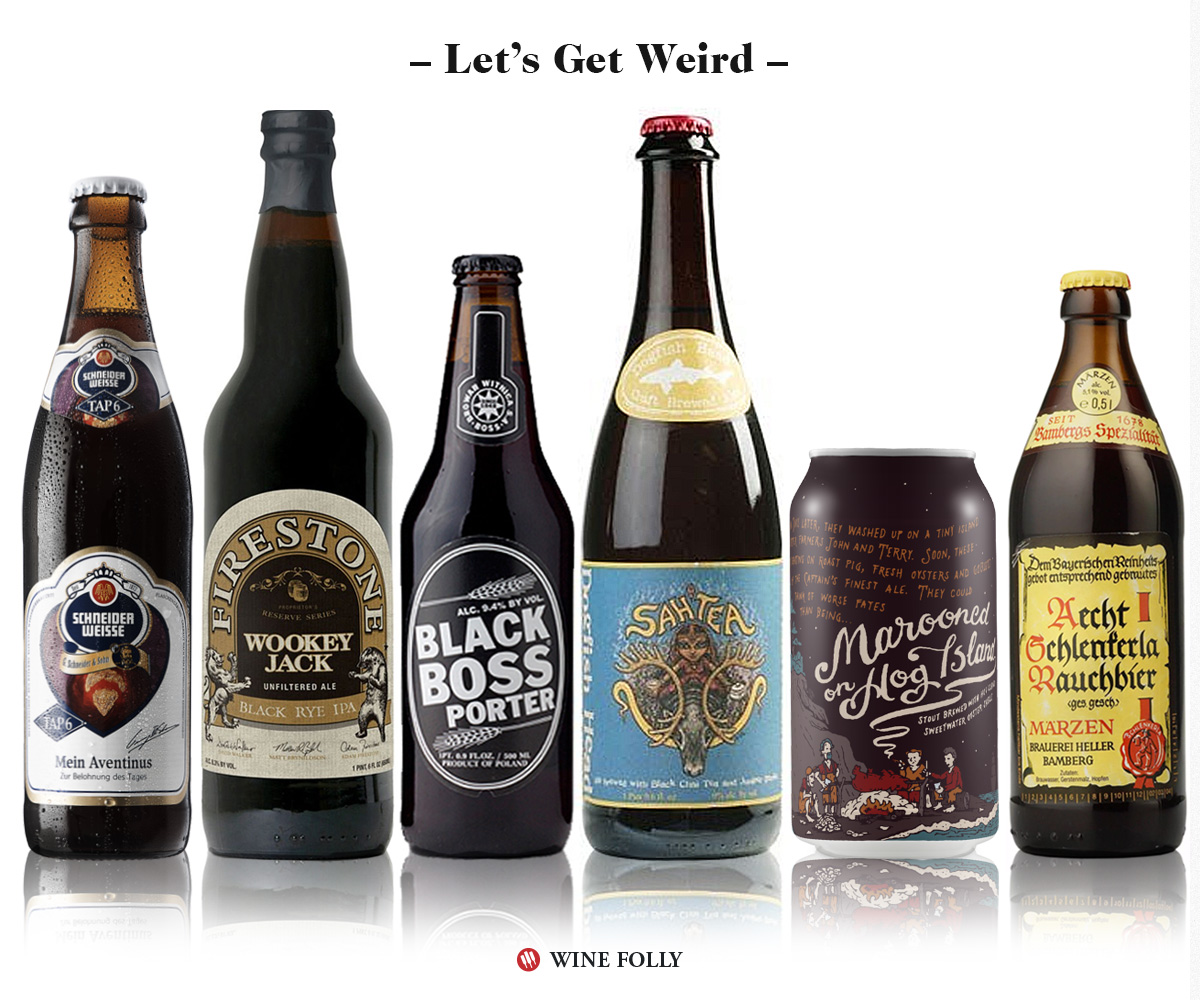32 wines for beer lovers. 32 beers for wine lovers. Everybody wins with this comprehensive guide.
We’re not just wine geeks at Wine Folly, we’re beer geeks, too! Why wouldn’t we love beer? Much like wine, there’s a rich history behind the drink, endless variations and styles, and countless flavor compounds to sift through.
Also, most importantly, it just tastes good. Like, really good.
If you’re a beer drinker looking to make the jump from the taproom to the tasting room—or a wine drinker looking to do vice versa—this is the read for you.
32 Wines for Beer Lovers
Table of Contents
Crisp, Clean, & Light
Lager & Pilsner
- Example: Czechvar Budvar, Bitburger Pilsner
- Typical Flavors: malt, baked bread, mineral water, fresh flowers, grain
- Wine to Try: Cava (Brut Nature)
Lovers of all things light, crisp, and refreshing need to trade in their steins for a flute of Cava Brut Nature. This extra bright, extra dry Spanish sparkler is an affordable, approachable gateway into the world of wine and pairs well with all manner of salty pub fare.
Cream Ale
- Example: New Glarus Spotted Cow
- Typical Flavors: corn, malt, lactose, cream soda, coconut
- Wine to Try: Muscadet et Sur Lie
Made from the fruity, acidic Melon de Bourgogne variety and aged on suspended dead yeast particles, this style of Muscadet develops a more robust and bready character that’s an easy entry point for lovers of the thirst-quenching ale.
Hefeweizen
- Example: Weihenstephaner Bräuweisse
- Typical Flavors: banana, bubblegum, citrus, cream, clove
- Wines to Try: Beaujolais, Schiava
If you love the more classic banana esters found in German Hefeweizen, you’ll find a similar flavor (and easy-drinking structure) in a younger Beaujolais. However, if you dig more of the bubblegum notes, you may want to say buongiorno to the obscure Italian grape, Schiava.
Witbier
- Example: Avery White Rascal
- Typical Flavors: coriander, orange peel, white tea, honey
- Wine to Try: Gewürztraminer (Dry)
Only one wine comes to mind for the cloudy, quaffable Belgian-style ale with a spice-driven kick: Gewürztraminer. Preferably a dry, somewhat aged one to get not only those citrus and floral notes, but a hint of warm spice as well. Much like Witbier, Gewürztraminer also pairs well with Indian and Arabic cuisine and more exotic fare.
Kölsch
- Example: Reissdorf Kolsch
- Typical Flavors: cracker, bread, crisp, mild orchard fruit
- Wine to Try: Prosecco (Brut, Extra Dry)
Consider in lieu of this clean, pleasantly bitter ale from Cologne, Germany a Brut or Extra-Dry Prosecco. The drier Brut will have a similar mouthfeel and finish to most Kölsch, but if you’re all about those cracker and bread flavors, go for the somewhat sweeter, misleadingly named Extra Dry style.
Belgian Golden Strong Ale
- Example: Delirium Tremens
- Typical Flavors: white spice, citrus, flowers, hops
- Wine to Try: Grenache Blanc
Nicknamed the “Devil’s Ale” in Belgium, these beers earn their reputation by looking as light as a lager does, while packing a graceful, but significant alcoholic punch (7-12% ABV.) Grenache Blanc does a similar dance by also looking light and approachable, while having a similar hidden kick (13-15% ABV.) Plus, these wines can be just as fruity and floral as a Belgian Strong Pale Ale, and even a bit hop-like with the characteristic green notes!

Malty, Medium-Bodied, & Hoppy
Amber Ale / Red Ale
- Example: Tröegs Nugget Nectar
- Typical Flavors: malt, caramel, whole wheat bread, mild fruit
- Wine to Try: Sherry (Amontillado)
Time to get fortified. It is difficult to find a wine that’s on the same wavelength as the occasionally hoppy, malt-forward Amber/Red Ale. In making the correlation, our minds went right to Sherry, more specifically, Amontillado Sherry, for its nuttiness, richness, and fine oxidized flavors. Just make sure you pour yourself a smaller glass with that elevated ABV!
Brown Ale
- Example: Samuel Smith’s Brown Ale
- Typical Flavors: earth, dark fruit, caramel, biscuit, dark spice
- Wine to Try: Teroldego
Big on the browns? We’re going to give you an hip variety to consider: Teroldego. This Northern Italian red grape is known for making dark, bitter, and balanced wines with earthy and flowery backbones. As it’s known for being somewhat astringent, it’s not the smoothest of parallels to brown ale, but we’re banking that like us, you’re all about those earthy flavors.
Bock
- Example: Ayinger Celebrator Doppelbock
- Typical Flavors: plum, crystallized fruit, molasses
- Wine to Try: Malbec
This thicker-than-your-average lager begs for a bolder wine. Plummy, dark, and full-bodied, you’ll have no problem swapping one out for a smooth Argentine Malbec.
Pale Ale
- Example: Sierra Nevada Pale Ale
- Typical Flavors: citrus, hop, straw, bread, biscuit, pine
- Wines to Try: Sauvignon Blanc (Cool-Climate), Vermentino (di Sardinia), Soave
Get the clean and grassy flavors you crave with Sauvignon Blanc from New Zealand, Loire Valley, and Chile. Trust us, it’s like taking in a freshly mowed lawn. If there’s a wine that is certain to turn you from a budding hop head to a serious white wine enthusiast, this just might be it…
Pro-Tip: If you’ve already experienced the unreal Pale Ale-Sauvignon Blanc connection, make the leap to lean Vermentino from Sardinia or springy Soave Classico.
India Pale Ale
- Example: Bell’s Two-Hearted IPA
- Typical Flavors: citrus, hop, cannabis, fresh herb, flowers, resin
- Wines to Try: Grüner Veltliner, Riesling (Dry)
Hopheads and New England-style obsessives, please bring your attention to Grüner Veltliner. This Austrian variety is known for producing dry, acidic, citrus-driven wines that have been known to make IPA drinkers say, “Whoa.” Careful, one sip and you may never go back to drinking beer again…
Pro-Tip: If Grüner is just a little too hard to find, snap up a nice dry Riesling and join us in wondering how anyone can not love this grape.

Succumb to the Dark Side
Porter
- Example: Deschutes Black Butte Porter
- Typical Flavors: coffee, bittersweet chocolate, smoke, black bread
- Wine to Try: Sagrantino
Bitter, swarthy, palatable…wait, are we describing your modern-day Porter or Sagrantino? However, consider yourself warned: you may find the beer to be a bit of an easier drink. Sagrantino di Montefalco makes for one of the most tannic wines on the planet! Your mouth may not know what hit it.
Stout
- Example: Guinness Stout
- Typical Flavors: bitter chocolate, coffee, licorice, stone, savory herbs
- Wine to Try: Classic Médoc (Left Bank) Bordeaux
Known for gravelly soils and Cabernet Sauvignon-dominant red wines, the Left Bank is where you want to look when switching from stout, specifically the Médoc region. The wines from this section of Bordeaux are known for being bold, concentrated, and filled with complex secondary aromas/flavors (cigar box, leather, tobacco) that will be music to any stout lover’s, uh, mouth.
Dubbel & Belgian Dark Strong Ale
- Example: North Coast Thelonious Monk
- Typical Flavors: caramel, dark sugar, plum, dates, figs
- Wine to Try: Port (Ruby, Late Bottle Vintage)
The Dubbel and Belgian Dark Strong Ale can be considerably different beer styles, and normally we wouldn’t loop them together. The problem here is that we found the perfect wine to hit all those delicious dark sugar, plum, and date flavors on the nose: Port. Specifically, Ruby and Late Bottle Vintage styles that are more fruit-forward, affordable, and meant to be enjoyed young.
Scotch Ale / Wee Heavy
- Example: Orkney Skullsplitter
- Typical Flavors: caramel, malt, peat, tea, heather
- Wine to Try: Cognac (V.S.)
As Scotch Ales are smooth, malty, and beg to be savored instead of quickly thrown back, we recommend reaching for a younger V.S. (Very Special) Cognac. With notes of caramel, toffee, leather, coconut, and spice notes, Cognac is pretty much guaranteed to be your thing. Get the right glassware, swirl, and enjoy. Maybe even get a mirror to see how cool you look as you drink it.
Winter Warmer / Christmas Ale
- Example: Great Lakes Christmas Ale
- Typical Flavors: cinnamon, orange peel, vanilla, cloves
- Wine to Try: Mulled Wine/Glühwein
Beer drinkers use winter warmers to get through the cold season. Wine drinkers use Glühwein. Why not drink both? If you’re looking to make your own from scratch, go with a full-bodied red wine like Syrah or Malbec.

High-ABV Territory
Tripel
- Example: Tripel Karmeliet
- Typical Flavors: pear, lemon, white cherry, white bread, cream soda
- Wine to Try: Rosé Sparkling Wine (Domestic Sparkling Wine, Cremant D’Alsace)
Golden, dense, and complex, the singular Tripel is one of our favorite beers here. Gorgeous as it may be, it needs to be consumed with some caution. Much like the Belgian Golden Strong Ale, it looks deceivingly light, but packs enough of an alcoholic punch to cut a night out short. So if you’re craving those sweeter, fruitier flavors and a similar creamy mouthfeel, consider a lower-octane Rosé Sparkling Wine, either domestic or from France’s Cremant stylings.
Pro-Tip: Cost not an issue? Investigate nuttier, breadier, and oh-so-decadent Vintage Champagne. Yes, it could break your budget. But it will also break your brain (in a good way.)
Double/Imperial India Pale Ale
- Example: Alchemist Heady Topper
- Typical Flavors: pine, grapefruit, tree sap, resin, cannabis
- Wine to Try: Retsina
Grüner Veltliner and Dry Riesling will still do the trick for most IPAs, but if you like them extra dank and sticky, we’re gonna send you in Retsina’s general direction. This Greek wine isn’t for the faint of the heart (even for those who love wine), with its pine, resin, and lime peel flavor profile. But hey, if you love DIPA/IIPAs, we probably had you at “not for the faint of heart!”
Double/Imperial/Russian Stout
- Example: North Coast Old Rasputin Russian Imperial Stout
- Typical Flavors: strong coffee/espresso, burnt sugar, hearty oats, dried dark fruit
- Wine to Try: Australian Shiraz
Big, brawny, and known for its aggressive flavor profile, this souped-up stout needs something that’s equally broad-shouldered. Enter Aged Australian Shiraz. Rugged and animalistic, this style of Syrah features flavors of mocha, graphite, savory meat, as well as a high alcohol content thanks to the abundant Down Under sunshine.
Bourbon-Barrel-Aged Stout
- Example: Goose Island Bourbon County Stout
- Typical Flavors: bourbon, wood, burnt sugar, vanilla, fudge, char
- Wine to Try: Sherry (Oloroso)
Expensive to produce and requiring some serious patience to brew, the Bourbon Barrel-Aged Stout is often the gem in any beer enthusiast’s cellar. They’re rich, complex, and one of the surest bets to get better with age. For wines, Oloroso, the beautiful mistake of the Sherry business, is a great go-to. Occasionally, the flor (a special yeast used to make Sherry) dies, and then that Sherry is taken into barrels to age. The end result is a deep, dark, and dry fortified wine with parallel wood, fudge, and burnt vanilla notes.
Quadrupel
- Example: Trappistes Rochefort 10
- Typical Flavors: raisins, dates, fruitcake, gingerbread, earth, anise
- Wine to Try: Sherry (Pedro Ximénez)
The brawny, yet delectable Quadrupel may have fit under the “Belgian Dark Strong Ale” umbrella, but we found that in our experiences with Rochefort and Westvleteren, we got something even a little more heavy. After we nailed down flavors of fruitcake, raisins, and even some gingerbread, we thought there was a better fit than Port. Syrupy Pedro Ximénez (a grape, not a person) Sherry won our hearts with its luscious profile of figs, dates, and fireside spices.
Old Ale & Barleywine
- Example: Great Divide Old Ruffian Barleywine
- Typical Flavors: alcohol, English toffee, treacle, hard candy, butterscotch
- Wine to Try: Madeira (Bual)
There’s nothing subtle about Barleywine or even Old Ale, its more sessionable equivalent. There’s often not even an attempt to hide the alcohol and it is absolutely thick with fruity esters, malts (English) and hops (American.) The fortified Portuguese island wine, Madeira, is a great go-to with its flavors of roasted nuts, stewed fruit, and toffee. We especially like the sweeter Bual style with its additional salted caramel, golden raisin, and date smells and tastes.

Sour ‘n’ Funky
Saison / Farmhouse Ale
- Example: Fantome Saison
- Typical Flavors: hay/straw, barnyard, white pepper, orange, lemon, lime
- Wine to Try: Rosé of Tempranillo, Rosé of Syrah, Natural Wine
Ooh, tough call. There can be quite a range in tastes when it comes to Saison, but we’ve got some good options for one of our personal favorite styles of beer. If you like the more peppery style of Saison, consider Rosé of Tempranillo or Syrah. You’ll find these specific styles of rosé more herbaceous and savory, rather than abundantly fruity.
Pro-Tip: If you’re all about the farmhouse funk/brettanomyces in your beer, you might be game for a more untamed natural wine (wine made with minimal human interaction.)
Sour (Gueuze, Gose, & Berlinerweisse)
- Example: Gueuze Tilquin
- Typical Flavors: lemon juice, lime peel, grape must, apple cider, salt
- Wine to Try: Orange Wine
This one is a no-brainer. Orange wine, which is white wine made by keeping the skin and seeds in contact with the juice, is designed for the sour beer lover. It’s acidic, tart, and assertive with atypical aromas and flavors (jackfruit, linseed oil, brazil nuts, sourdough). Sound like any beer you know?
Fruit Lambic
- Example: Lindemans Framboise Lambic
- Typical Flavors: fresh fruit flavors
- Wine to Try: Lambrusco, Beaujolais Nouveau
If you enjoy fruit lambic beers (Kriek, Cassis, Framboise), then you should, nay, MUST try Lambrusco. This sparkling red wine comes in a range of dry and off-dry styles, but always with up-front fruit flavors. Depending on the style, you can even find some additional cream, chocolate, and floral notes! Who can resist?
Pro-Tip: Made the Lambic-Lambrusco connection? Dig a Beaujolais Nouveau! (Bojo Nouveau, if you’re nasty.) This ultra-acidic, quickly-made wine features lush, juicy aromas of raspberry, cranberry, candied fruits, banana, and even bubblegum.
Flanders Red Ale & Oud Bruin
- Example: Duchesse de Bourgogne
- Typical Flavors: green apple, balsamic vinegar, sour grapes, oxidized fruit
- Wine to Try: Blanquette de Limoux / Mauzac
With strong vinegar, green apple, and earthy flavors, these two sours can be a bit of a curveball to the uninitiated. Fortunately, the wine we’re recommending is way more accessible, if but a bit overlooked! We submit to you: Blanquette de Limoux, a dry style of sparkling wine from France’s Languedoc-Roussillon region that prominently features the ancient, esoteric Mauzac Blanc variety. Peachy, grassy, and flush with green apple notes, you best be getting to your local wine shop right now.

Let’s Get a Little Weird
Weizenbock
- Example: Schneider Weisse Tap 6 Unser Aventinus
- Typical Flavors: vanilla, clove, malt, nutmeg, cinnamon
- Wine to Try: Vin Santo
Fans of this malty, ester-apparent, bock-strength Dunkelweizen should seek out Vin Santo, an intriguing Italian dessert wine known for its vanilla, caramel, honey hazelnut, and dried apricot flavors. Like Weizenbock, it’s a wondrous balance of deliciousness and intensity that will stick to the side of your glass. Drink up.
Cascadian Dark Ale / Black IPA
- Example: Firestone Walker Wookey Jack
- Typical Flavors: coffee grounds, lime peel, tree resin, roasted grain
- Wine to Try: Carménère
Already a beautiful blend of the fruity, sweet, and bitter, this dark-grained IPA is a little more smoky and complex. (Best description? Like a lime squeezed into a cup of coffee. Yum.) Savory, herbaceous, and equally fruity South American Carménère might be just what you’re looking for.
Baltic Porter
- Example: Black Boss Porter
- Typical Flavors: roasted grain, alcohol, black licorice, balsam, sarsaparilla
- Wine to Try: Aglianico, Valpolicella (Ripasso, Amarone)
Originally designed to withstand colder climates and conditions, these lagers (yes, they’re bottom-fermenting!) have all the body, alcohol, and flavors you’ve come to expect from heavier stouts — with a little something extra. Something so hearty, so brooding needs a wine to match. That’s why our hive mind went to Aglianico, a full-bodied, high-tannin red wine with notes of smoke, game, and spiced fruit. Aglianico del Taburno and Aglianico del Vulture make for great, affordable gateway wines.
Pro-Tip: While we doubt we can convince anyone to switch out their Baltic Porter (~$8) for the rich and heady Amarone della Valpolicella ($50+) of lore, if you’ve got the money, go for it.
Sahti
- Example: Dogfish Head Sah’Tea
- Typical Flavors: juniper, resin, peppercorn, cardamon, twigs
- Wine to Try: Vermouth
Boasting an aromatic head and broad-shouldered body, this primitive Finnish beer is a unique treat. We’re going to assume if you’re crazy about Sahti, you’re probably crazy about its signature juniper character. That calls for Vermouth. Open and shut case.
Oyster Stout
- Example: 21st Amendment Marooned on Hog Island
- Typical Flavors: mollusk, brine, sea salt, dark grain
- Wine to Try: Muscadet
Dry stouts make for a hell of a pairing with shellfish. They also make for a hell of a pairing in the beer itself, giving a briny and saline character to a dark, easy-drinking brew. Recommending a light, refreshing white wine like Muscadet feels like a far cry from a black ale—that is until you realize it too is dry, saline, and goes great with the treasures of the sea.
Rauchbier
- Example: Aecht Schlenkerla Rauchbier
- Typical Flavors: smoke, wood, malt, bacon, savory spice
- Wine to Try: Rioja (Aged), Syrah (Old World)
There’s a lot of drinks that could be described as smoky, but few are as in your face about it as a Rauchbier. It’s not just smoky, either. It’s also spicy, savory, and meaty with some people even noting a bacon flavor! The smoke and leather of an aged Rioja sounds like an excellent substitute, but you’d also do well with an Old World Syrah and its earth and bacon-fat characteristics.
Last word: Did we miss your favorite style of beer? Looking for a wine to pair with it? Let us know in the comments and we’ll try to work our recommendation magic!

